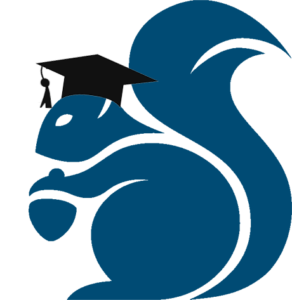A Squirrel’s Tale
Proudly perched atop a plinth over the mantel in the informal front parlor at the John Brown House Museum is a striking statue. No, it’s not a bust of Milton or Minerva, who graced the rooms across the hall, but a rather furrier figure: a grey squirrel. Carved out of mahogany, and joined by a scurry of French red squirrels in the vibrant trompe l’oeil wallpaper, this little grey beast has been welcoming visitors to the mansion on the hill for more than 230 years. Well, actually, the original squirrel lives in collections storage, but a squirrel has stood in this place since the house was constructed in 1788.
Why? We don’t actually know. While the records of the Brown family abound, we’ve not found even a scribble on why the “Most Magnificent Mansion” would so prominently feature a squirrel. Some of our staff and docents over the years have hypothesized that it was because John Brown could not sit still and prized all industrious actions. Perhaps. We know that John  Brown was quite interested in French philosophy, including the work of Rousseau and Voltaire. In 1779 Voltaire wrote about King Louis XIV and his one beloved but later disgraced and imprisoned Superintendent of Finances, Nicolas Fouquet. Fouquet’s fortunes fell far, but largely because he had amassed such power and money. In fact, Fouquet’s crest was a squirrel, and under the animal it read “Quo non ascendam,” or “Where shall I not ascend.” Had John Brown been struck by this story? Or maybe, just maybe, one of his beloved daughters simply loved the little creatures, and he wished to enchant her.
Brown was quite interested in French philosophy, including the work of Rousseau and Voltaire. In 1779 Voltaire wrote about King Louis XIV and his one beloved but later disgraced and imprisoned Superintendent of Finances, Nicolas Fouquet. Fouquet’s fortunes fell far, but largely because he had amassed such power and money. In fact, Fouquet’s crest was a squirrel, and under the animal it read “Quo non ascendam,” or “Where shall I not ascend.” Had John Brown been struck by this story? Or maybe, just maybe, one of his beloved daughters simply loved the little creatures, and he wished to enchant her.
While one day we hope to know what John Brown was thinking, we know for sure that the squirrel over the mantel holds a special place for many of us. So, when it was time for us to look for a new logo, a new brand, we thought our squirrel might do the trick.
No matter what Brown might have been thinking, we saw the squirrel as a wonderful representation of the RIHS. Tirelessly gathering items to be stored for later use. Tending them with care and knowing just where to find them later, the squirrel seems to us to be the historian of the animal kingdom. And did you know that a squirrel’s brain is the size of a walnut, the same as a crocodile’s brain (this might tell us more about crocodiles, actually). But, even more impressive is that in the fall, the part of the squirrel’s brain devoted to memory is 15% larger in the fall when they are gathering and hiding their nuts for the winter!

We also thought that the squirrel was a perfect symbol for the Museum of Work & Culture. The écureuil is a model of industry and busy-ness, nimble and adaptive to its changing conditions.
So, the squirrel it was. But what to call it? We weren’t sure, so we decided to ask you: the public. Our “Name the Squirrel” contest brought forth more than 100 names and we selected the entry by our member Ginny Leslie. Ginny thought it only appropriate that we look to our historical sources and suggested that we name the little one Mishanneke-quock, the Narragansett word for squirrel, as explained by Roger Williams in his 1643 text, A Key Into the Language of America. And we wholeheartedly agreed.
For everyday use, however, that was a bit of a mouthful, so our squirrel got a nickname – Misha.


